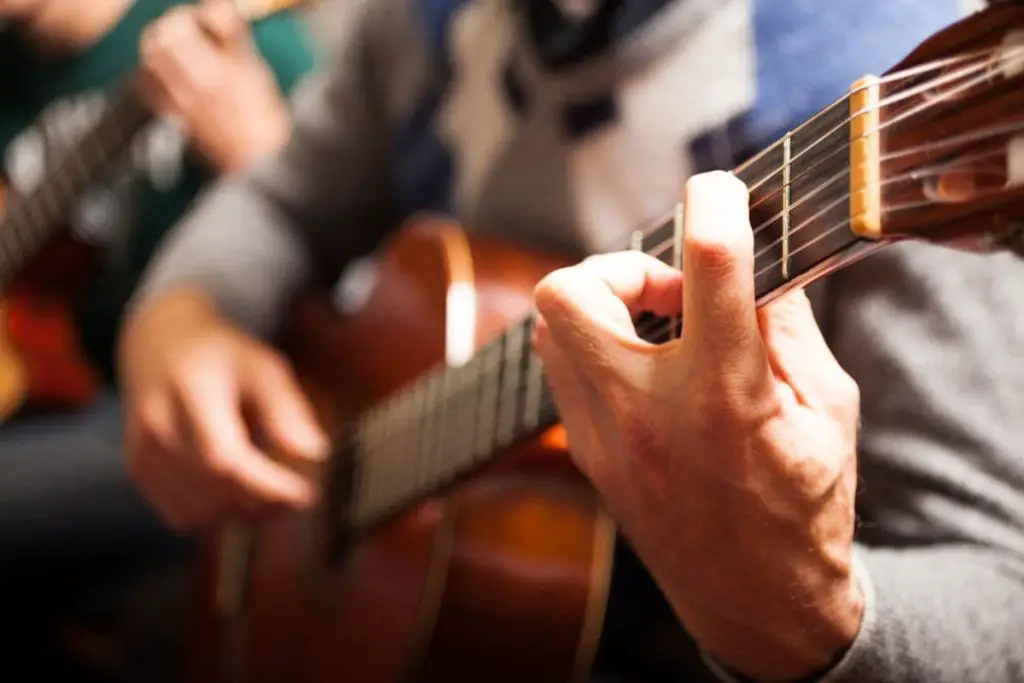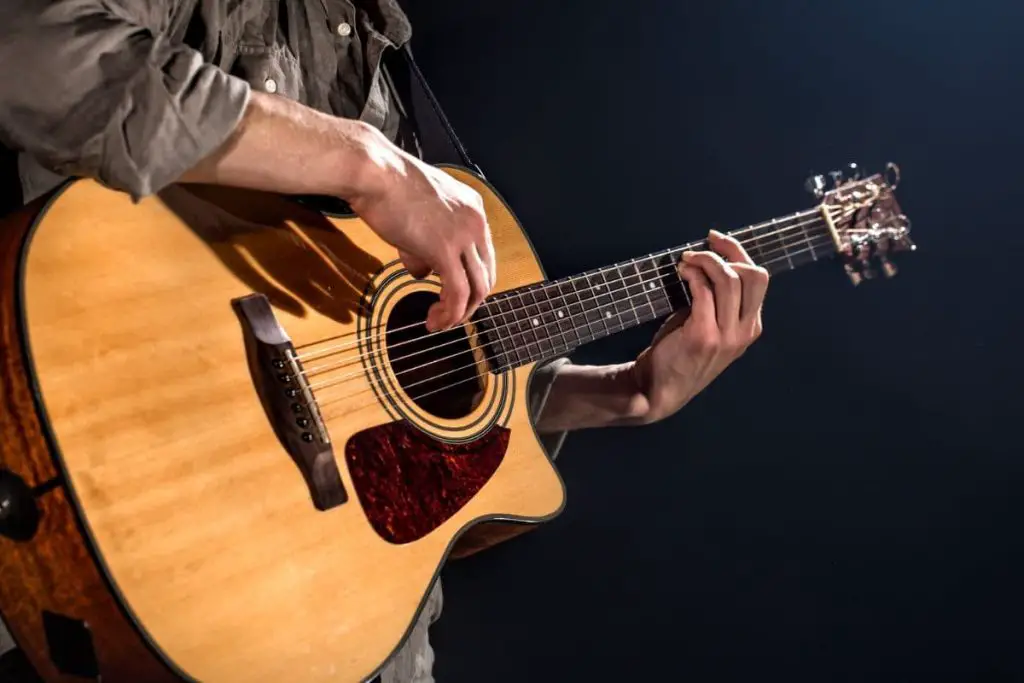Guitar chords are the backbone of popular music, as songs are typically built around them. While learning how to hold and play them is strongly emphasized in guitar learning, figuring out the theory behind them and learning how they really work is often seen as less important. However, learning the basics of chord theory will deepen your understanding of music and allow you to become more creative and expressive with your songwriting.
Chords are based on the major scale, and always consist of three tones. Major chords consist of the first, third, and fifth notes. Minor chords have a flat third instead of a natural third. Notes are typically played more than once in a chord. Power chords are different and consist of two notes.
Don’t worry if your head spins from confusion at the thought of the theory behind guitar chords. The guide below will explain the basics of how guitar chords work and give you some basic knowledge that you can build on and expand.
If you want to find out what my recommended guitar gear is, then here is what I recommend on Amazon:
- Fender Cutaway Acoustic-Electric Guitar Bundle (MY FAVORITE GUITAR)
- Snark SN-8 Super Tight All Instrument Tuner (Easiest Tuner I’ve Used)
- 6 String Acoustic Guitar Capo (Best CAPO for quick changes)
- Dunlop Max Grip 1.0mm Nylon Picks (Thick Guitar Pick So You Don’t Lose Grip!)
- Universal Guitar Stand (Cheap & Minimalist Guitar Stand I Recommend)
- Levy’s 2″ Wide Quick Adjust Guitar Strap (Best Guitar Strap For Any Level)

How To Build Chords
Even though it might seem this way at first, chords are not just random strings of notes that we put together and agree that they sound good. We base chords on scales and, most of the time, chords are based on the major scale.
You can also create chords based on other scales, but this is less common, particularly in Western music. Doing it this way would also make things a bit too complicated, so for simplicity’s sake, it’s agreed that chords are based on the major scale because that’s the one we see as the master scale.
You can also build chords outside scales, but that’s quite a complex matter, and it’s much easier to base them on scales. Unless you’re into super-avant-garde music, all the chords you play will be based on scales. However, if you are into super-avant-garde music, you’re probably not reading this guide.
Now that I’ve explained what (most) chords are made from, I’ll examine how to build them. That is, I’ll describe how to pick notes to construct chords. There are actual rules, and they’re not difficult to grasp.
Major Chords
Chords consist of three notes, at least in their basic shapes. When it comes to major chords, we use the first, third, and fifth. With minor chords, the third is flattened, which means you go half a tone down.
This might seem a bit abstract at first, and you might wonder what these ordinal numbers refer to.
Well, it’s actually quite simple. When we say “first”, we are referring to the first note of the scale. This is also known as the root note, and it’s also the note which gives the chord its name.
Likewise, when we say “third” and “fifth,” we are referring to, you’ve guessed it, the third and fifth notes on a scale. I’ll explain below how this works in practice.
Assuming one takes the C major chord as an example. Obviously, this is based on the C major scale. The scale consists of the following notes: C – D – E – F – G – A – B – C. The first note here is C, the third is E, and the fifth is G. Therefore, the C major chord consists of notes C, E, and G.
But hang on a minute! When we play chords, we usually play more than three notes. So, how is that possible if there are only three notes in a chord? It’s possible because we can repeat the same note in a chord; we just play it in a different position on the fretboard.
To go back to the example of C major, we play C and E twice, and G once in that cord. We play C on the third fret of the A string and on the first fret of the B string. E is played on the second fret of the C string and the open E string. G is played on the open G string, the reason it looks like there are more than three notes, but there are only three.
Of course, chords can get more complicated than this. For example, you can play the open B string, which introduces B (the seventh note in the scale), and gives you the C major seven chord. There are almost countless variations, so I’ll stick to the basics for now.
Minor Chords
Minor chords work in a similar way. There is one big difference, however. You use the same notes, but the third is flattened. So, instead of I – III – V, you use I – IIIb – V. The “b” stands for “flat,” meaning that it’s half a step lower than it would be in the major chord.

Let’s stick to the example of the C major chord. To turn it into C minor, we have to turn the third note, E, into an Eb. Of course, there are many variations here as well, but this simple example illustrates the point well.
You might wonder why I’m referring to the major scale if I’m talking about minor chords. This is because the major scale functions as the main scale (hence the name), and we draw minor chords from it as well as the major ones.
At this beginning stage, we can simply accept it as a fact. Once you grasp the basics and decide to dabble more seriously in music theory, you can discover more obscure and complex variations. For now, I’m only discussing the basics.
What’s the Difference Between Major and Minor Chords?
I have already explained the technical differences between major and minor chords, but I haven’t touched on their sound differences. I’ll briefly examine their differences before proceeding.
In Western music, major chords, scales, and keys are seen as bright and happy-sounding. Minor chords, scales, and keys are viewed as somber and sad-sounding, as you’ve probably guessed. Therefore, if you play C major, it will sound cheerful, but its minor counterpart will sound rather sad.
Major and minor chords are usually combined for a livelier, more dynamic, expressive chord progression. Using only major or only minor chords in a song usually makes it sound a bit off, and such progressions may sound a bit flat and inexpressive. This is not to say that it’s impossible to pull off such a progression, it’s just not the norm.
What Are Diminished Chords?
You’ll often find chords referred to as “diminished” when learning new songs and figuring out how to play them. This might seem a bit confusing, as “diminished” implies that something is lessened, but it’s probably unclear what.
The word actually refers to the treatment of the fifth note. In a diminished chord, the fifth is flattened, or, in other words, diminished, which gives these chords their name.
They are built similarly to minor chords. However, instead of I – IIIb – V, you have I – IIIb – Vb. Therefore, instead of one flattened note, there are two. In a way, you can think of diminished chords as extra minor chords. Just make sure you never say this aloud in front of guitar nerds because it’s not a theoretically-correct way to think about them; it’s just a way to remember what they are.
Diminished chords also sound sad and suspenseful, leaving the listener waiting for a resolution. They’re a great way to spice up your chord progressions and make them more interesting and dynamic.
Of course, diminished chords can also get progressively complicated, and you will often find diminished seventh chords and even half-diminished seventh chords. The possibilities are almost endless, and once you get the hang of how this all works, you’ll be able to explore and create unique combinations of sounds.
How Do Power Chords Work?
Power chords are a staple of heavy music as they allow you to change chords quickly and strum hard. They’re an essential item in any guitarist’s toolbox, particularly if they’re into rock and its various offshoots. If this is your area of interest, it’s important to become familiar with power chords and how they work.

You have probably noticed that power chords have different shapes than regular chords. In fact, power chords mostly have the same shape that you simply apply to different root notes to get different chords. This may seem interesting since it seemingly goes against what I’ve explained about chords so far.
I’ll examine power chords in more detail and describe how they work below:
What Are the Notes in Power Chords?
You have probably noticed that there are fewer notes in power chords than in regular chords. This is a correct observation.
Unlike a regular chord, a power chord doesn’t have the third note that gives a chord its major or minor quality. Power chords are just power chords; they’re neither major, nor minor. Instead, a power chord is based on the root and fifth.
Guitarists usually add the root note in a different octave to make the sound fuller. This makes it seem like there are three notes, but there are still only two. This is the most common way to play power chords, but you don’t need to do this.
I’ll examine the G power chord below so that you can see how it works in practice.
To form this power chord, you start by placing your index finger on the G note. That’s the third fret on the E string, and you’ll always hold the root note with your index finger.
After that, you need to find the fifth. Usually, you’ll go two frets and one string up. In this case, that’s the fifth fret of the A string, and you should press it with your ring finger.
Thus, you get a chord that only consists of notes G and D; the root and the fifth. If you hold that chord and strum, you’ll get a nice heavy sound. However, you can make it fuller and slightly heavier, which can be achieved by adding the root note in the other octave.
To do that, go one string up from the fifth but stay on the same fret. Use your pinky for that. This adds another G note to the chord, but it’s higher this time. This will round up the power chord and make it sound thicker and fuller, which is probably what you’re looking for if you’re playing power chords.
This is the basic power chord shape. You can leave your fretting hand in the same shape and simply move it around the fretboard to get different power chords, the reason they’re so popular in fast and heavy music. They make it very easy and simple to move from chord to chord, plus it’s much easier to strum two or three strings instead of four, five, or six.
There is an alternate way to form power chords. Instead of using your ring finger to press the fifth and your pinky to press the octave of the root note, you can hold both with your ring finger. This might make it even easier to use power chords, particularly if you’ve got big hands, so there’s not enough space for both fingers.
How To Use Power Chords
Power chords are a great tool for rhythm guitarists, particularly if they aim to create a fast-paced rhythm that accompanies a heavy drum beat. Their simplicity allows you to change them very quickly and strum at a fast tempo.

They can also be a great accompaniment for fast guitar melodies (if there’s another guitarist in the background) and shouted vocals. In addition, they can be incorporated into something more melodic, especially if there are catchy sing-along choruses.
You can combine them with regular chords to shake things up and introduce more variety into the song. For example, you can reserve regular chords for the verse and power chords for the chorus. You can also do the opposite or combine them in a progression.
Since they consist of only two tones, they also allow a lot of room for the bass guitar to shine. While it’s common for the bass guitar to just play the root notes, there’s much more space for creativity than this.
Because the guitar plays only two notes, the bass can fill in the gaps and walk around the fretboard, which doesn’t just complete the guitar’s sound but also connects the guitar to the drums and creates a tight, cohesive sound.
For similar reasons, they’re also a good background for brass instruments and keyboards. They lay the foundations, and then the melody is built by the other instruments. That’s why power chords are widely used in ska and reggae, which feature brass instruments prominently.
How Many Chords Should You Know?
The number of chords you should know depends only on your needs. While there are hundreds of chords you can learn, it’s probably impossible to know all of them and be able to recall them at any time. Most guitarists stick to the basic chords, such as E major or A minor, and add some less common chords they like to use to the mix if necessary.
You can usually get away with using very few chords if you know how to combine them in a creative and innovative way. It’s even better if you’re a good rhythm guitarist and can create cool rhythmic patterns with only a few chords at your disposal.
Many songs rely on two or three chords only, with most not using more than five. There’s no need to go overboard with the number of chords because it’s not a competition to see who can cram the most chords into a song, and nobody wants a chord salad.
Focus on getting creative with the chords you know and using them in interesting ways. This will get you much farther than just trying to learn as many chords as you can only to squeeze a bunch of them in every song you write. Quantity is not quality in this case.

However, there are some basic chords you absolutely must know. If you’re familiar with power chords, you’ll automatically know a bunch, but we’ll focus on some open chords without which it might be difficult to play music. Open chords are simply chords that have at least one open string, and they can be seen as the backbone of music.
Open chords that you must know include, in no particular order:
- A major
- A minor
- A7
- B7
- C7
- C major
- D major
- D minor
- D7
- E major
- E minor
- E7
- F major (not really an open chord but it is often grouped with them)
- G major
- G7
Of course, there are a few other basic chords you should know. However, if you’re looking for a concrete answer to what chords you have to know, this list will help get you started. You can take it from there and experiment to find new cool chords you can include in your songwriting.
Don’t overthink it and overdo it. It’s better to practice four chords a thousand times than a thousand chords four times. This will give you a strong foundation and allow you to use the chords you know in interesting ways instead of squeezing them into songs.
Final Thoughts
So, that does it for this post! If there’s one thing you should absolutely remember, it’s that chords consist of three notes; the root, the third, and the fifth. In minor chords, the third is flattened, which gives it a somber sound. Good luck on your theory learning journey!
If you want to find out what my recommended guitar gear is, then here is what I recommend on Amazon:
- Fender Cutaway Acoustic-Electric Guitar Bundle (MY FAVORITE GUITAR)
- Snark SN-8 Super Tight All Instrument Tuner (Easiest Tuner I’ve Used)
- 6 String Acoustic Guitar Capo (Best CAPO for quick changes)
- Dunlop Max Grip 1.0mm Nylon Picks (Thick Guitar Pick So You Don’t Lose Grip!)
- Universal Guitar Stand (Cheap & Minimalist Guitar Stand I Recommend)
- Levy’s 2″ Wide Quick Adjust Guitar Strap (Best Guitar Strap For Any Level)
Related Posts:
- 7 Ways To Make Your Guitar Less Heavy & Lighten It
- How To Get Low Action Without Fret Buzz
- What To Do When a Whammy Bar Keeps Falling Out? (Loose Tremolo)
- How To Make Any Acoustic Guitar Louder (10 Ways)
- Why Is Your Acoustic Guitar So Quiet? 6 Reasons
- Why Does Your Acoustic Guitar Sound Tinny? 10 Fixes
- Should You Start With Acoustic Guitar? How to Decide
- Classical vs Acoustic Guitar for Child: Which Is Better?
- How To Know When To Change Guitar Chords in a Song
- How To Play Bar Chords On Acoustic Guitar (Easy Beginner Tutorial)
- Happy Birthday Guitar Chords and Melody (Learn How To Play Easy)
- Learn Guitar Notes: What Are The Notes On A Guitar?
- Who Invented The Guitar? The History of Guitar

